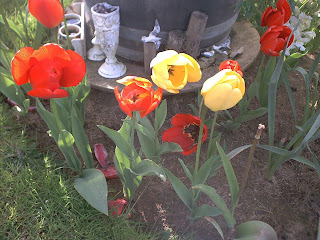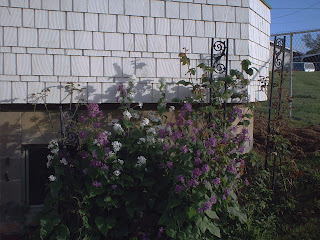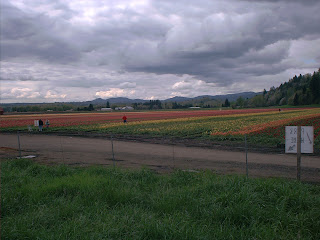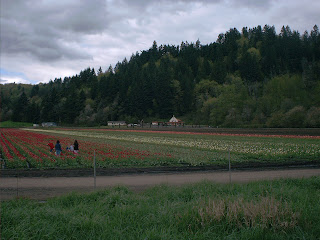Windstorm Closes Down Willapa Bay
Topic: Rural Living
It was a dark and stormy night .... yeah, yeah, yeah.
I got up yesterday morning, read the news, the blogs, worked on my fantasy basketball team and a Washblog entry until just before 9:00 AM.
One flicker ...
two flicker ...
three flicker gone.
Power went out and would stay out for close to 12 hours.
Now 2-3 weeks ago Bay Center suffered a power outage when trees fell on powerlines in South Bend (right next to the Pioneer Grocery Store) and cut power to everything south of that South Bend street all the way to Nemah just north of the Columbia River.
Lietta was gone and I had to struggle alone and unprepared for PUD powerlessness. I learned a few things including the harsh reality that when the power goes out, there goes the water ... ALL the water!
The commodes won't flush.
Apparently our water is pressured by an electric pump.
So this past Friday nite after work - all forewarned by newscasts of the coming storm - I filled every large and useable container I could find with water.
Including one multi-gallon plastic water jug that had no lid and was not too clean inside. I filled that one with the express purpose of flushing in mind.
I'd already stored up a modest supply of big D-size batteries for a boom-box CD radio we've had for years as well as two flashlights. Our supply of candles is adequate since we've always had a thing for candle-light dinners and stuff like that.
Yesterday morning after losing power but feeling more prepared, we took a driving tour all around Bay Center; devising detours and alternate routes where the water was over the roads and driving in a slow crawl over wind-blown debris where it was necesary.
After driving in a large loop, we pulled up to the Dock-Of-the-Bay tavern(formerly the Blue Heron Restaurant) where owner Ricki Bayne said she would cook breakfast (the stove is propane).
That idea ran aground when more folks came in to commune about the storm and eat. Ricki's water supply was inadequate to allow cooking for that many customers so only the beer-drinkers got nourished.
We went home and ate spanish omelets Lietta cooked on our own propane stove. With non-useable coffee-maker, we creatively pulled a Guardian Ware coffee pot we bought at a collectibles store off a shelf and made cowboy coffee with grounds in the bottom.
Dang good it was!
Made me want to put on a cowboy hat and some boots.
Visitors from across the street showed up around noon so we gave them each a bowl of Denali Moose Tracks Ice Cream that was getting dangerously soft in our ice-box.
We used the daylight to finally take down the Christmas tree which, since the tree is artificial and is assembled one branch at a time, took a very long leisurely time.
For supper we cooked by candle-light, Lietta working round steak into chunks and a gravy sauce to put on instant mashed-potatoes. She trusts me with cooking instant mashed potatoes and I added heated canned corn (she trusts me to heat up canned corn with a pad of butter on it).
We heated some of my stored drinking water in our teapot which is a fat goose that whistles when the water is boiling and whose head tilts up so the boiling water can be poured out of his neck.
Used that to make tea and clean all the dishes that wouldn't fit in the dishwasher which was full of Friday dishes (which I forgot to wash because I was too busy being a water warrior.)
So in our candle-lit kitchen warmed by cooking heat, we were cozy in a resigned-to-roughing-it kind of way.
Holy moly!
How did our ancestors survive candle-lit nights, an inability to adequately control heating and a struggle for useable water?
When did they find time for the Internet, Survivor, American Idol and CSI?
We surrounded the kitchen table with sufficient candles by which our mid-fifties eyesight could see to play Scrabble and soon became absorbed in out-wording each other.
After about 45 minutes a car drove by outside and Lietta looked up.
"Hey! Our neighbor's yard light is on. He must have a generator."
We looked around a realized that the light in our enclosed porch was on and the dog was glaring at us through the kitchen door window because it was suddenly too bright for him to sleep.
But still no water.
I guess the electric water pressure pump had to be - oh heck I don't know - primed?
So - still invested and engrossed in Combat Scrabble - we finished the game in an orderly manner, updated ourselves with TV news broadcasts and went to bed.
Lance the Dumb Cat woke me up at 3:00 AM and on my way through, I turned on a faucet.
"All day I faced the barren waste ...
without the taste of water ....
cool water ...
Water!!
I was flush with flushing pleasure!
My pioneer ancestors walked across the American Plains on the route of the Oregon Trail in 1856. They were pulling a handcart headed for Utah and went through more hell in two months than I have in a lifetime. (But that is another story.)
And I can just see them shaking their heads at my struggle and whining with 12-hours of no electricity.
With added perspective Lietta continues to contemplate the trials and travails of the Lewis and Clark Expedition which famously ended just down the road.
NOTE: For an excellent report on Grays Harbor and Pacific County storm damage check out today's Daily World (Aberdeen).
Posted SwanDeer Project
at 12:01 AM PST
Updated: Saturday, 7 April 2007 11:52 AM PDT





















